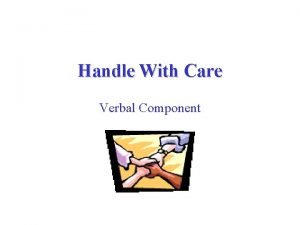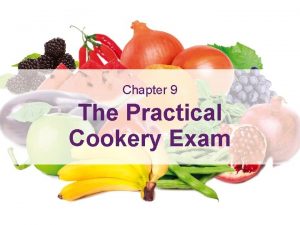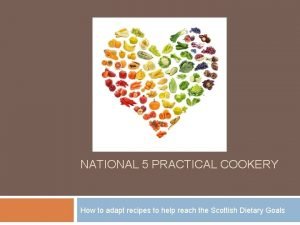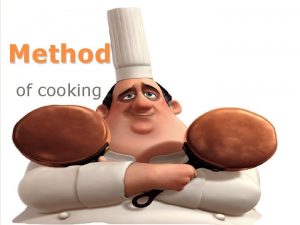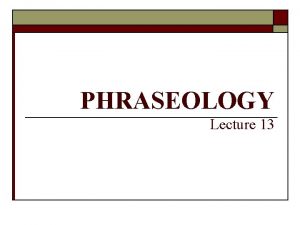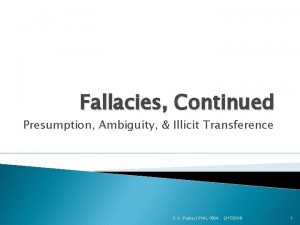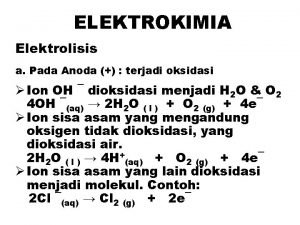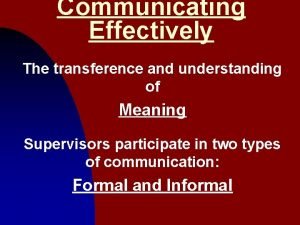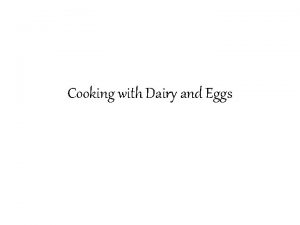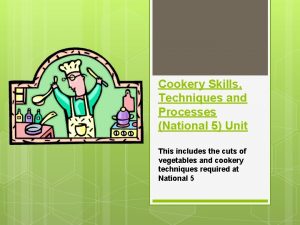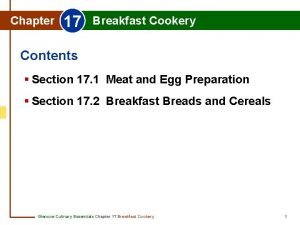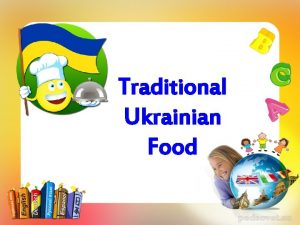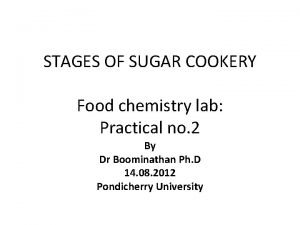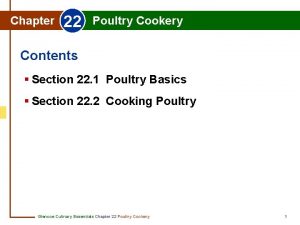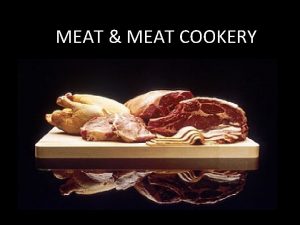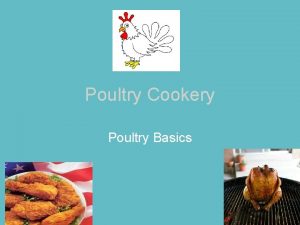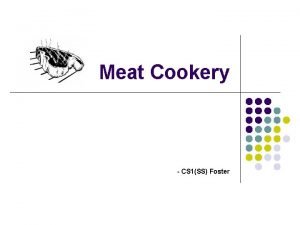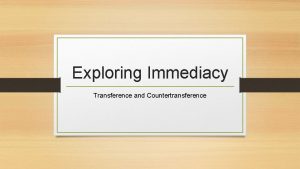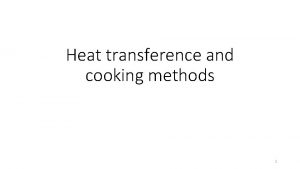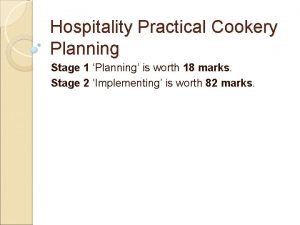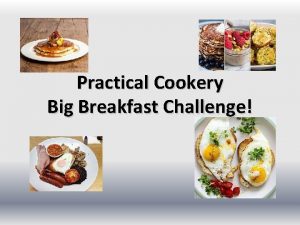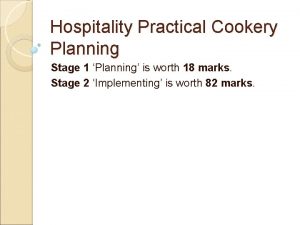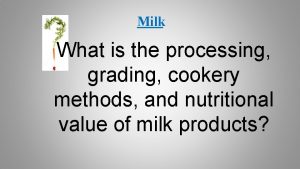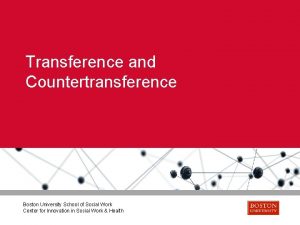Practical Cookery Methods of cookery The transference of






























- Slides: 30

Practical Cookery Methods of cookery The transference of heat to food

Practical Cookery Three basic principles • Radiation: heat travels from its source in direct rays until it falls on an object in its path. • Conduction: heat is transferred through a solid object by contact. • Convection: movement of heated particles of gases or liquids. On heating, the particles expand, become less dense and rise. The colder particles sink to take their place, thus causing convection currents, which distribute heat.

Practical Cookery • All methods of cookery depend on one or more of these principles. For example: – Grilling uses radiation – Solid electric ranges use conduction – Heating liquids uses convection – Gas ovens use convection.

Practical Cookery Boiling • Cooking in a liquid at boiling point. • Method 1: place food into boiling liquid, reboil, then reduce the heat for simmering (gentle boiling). • Method 2: cover food with cold water, bring to the boil, then reduce the heat for simmering.

Practical Cookery Purposes of boiling • Food is pleasant to eat, with agreeable flavour. • Food has an appropriate texture (tender or slightly firm). • Food is safe to eat. • Food is easy to digest.

Practical Cookery Poaching • Cooking in liquid at just below boiling point, but never boiling. • Shallow poaching: in the minimum of liquid. Used for cuts of fish and chicken. To prevent boiling, transfer to a moderately hot oven to complete cooking. • Deep poaching: in deeper liquid. Used for eggs and whole fish.

Practical Cookery Purposes of poaching • • Food is easy to digest. Food has a suitable tender texture. Food is safe and pleasant to eat. Sauce can be made with the cooking liquid, where appropriate.

Practical Cookery Stewing • Slow cooking pieces of food in the minimum of liquid, on a stove or in an oven: food and liquid served together. • Thickened consistency caused by: – Unpassed ingredients (e. g. Irish stew) – Thickening of the liquid (e. g. white stew/blanquette) – Cooking in the sauce (e. g. brown stew/navarin).

Practical Cookery Purposes of stewing • Food has acceptable flavour, texture and eating quality. • Cheaper cuts of meat, which would not be suitable for roasting or grilling, can be made tender and palatable by stewing.

Practical Cookery Braising • Cooking in the oven, in a covered pan/casserole/cocotte. Cooking in liquid, usually on a bed of root vegetables. • Combines stewing and pot roasting. • Brown braising: cuts and joints of meat are marinated (and sometimes larded), sealed quickly, then braised. • White braising: vegetables and sweetbreads are blanched, refreshed, then braised with white stock.

Practical Cookery Purposes of braising • Food is tender, digestible, palatable and safe to eat. • Flavour, texture and eating quality are improved. • Sealing meat for brown braising retains flavour and nutritional value, and gives a good colour.

Practical Cookery Steaming • Cooking by steam (moist heat) under various degrees of pressure. • Minimises the loss of nutrients during cooking. • Makes food pleasant, digestible, safe and nutritious.

Practical Cookery Methods of steaming • Atmospheric/low pressure – Direct, in a steamer or over boiling water – Indirect, between plates over boiling water • High pressure, in purpose-built steamers – No steam escapes, so pressure builds, temperature rises and cooking is quicker. Published by Hodder Education © John Campbell, David Foskett and Victor Ceserani

Practical Cookery Methods of steaming • Sous vide (vacuum cooking) – Raw food in vacuum-sealed pouches is cooked in a convection steamer. – The cooked pouch is quickly cooled and stored at 3˚C. – The pouch is reheated when needed. – Colour, texture, weight and natural juices of food are preserved. – Dishes can be garnished at the outset, saving labour and providing uniformity.

Practical Cookery Baking • Cooking in a pre-heated oven using dry convection heat combined with steam. • Makes food digestible, palatable and safe. • Gives food appealing colour, texture and eating quality.

Practical Cookery Methods of baking • Dry baking (cakes, pastry, potatoes): steam rises from the food during cooking. • Increased humidity (bread): a bowl of water or injection steam in the oven increases the water content of the food. • Heat modification (baked egg custard): food is placed in a container of water so that it cooks more slowly and does not overheat.

Practical Cookery Roasting • Cooking in dry heat with oil or fat. • Method 1: cooking in an oven with applied dry heat, forced airconvected heat or a combination of convected heat and microwave energy. • Method 2: cooking on a rotating spit over fierce radiated heat.

Practical Cookery Purposes of roasting • Food is tender and easy to digest. • Food is safe to eat. • Food is palatable.

Practical Cookery Pot roasting • Cooking on a bed of root vegetables in a covered pan, in an oven. • Coat food generously with butter or oil before cooking. • Food retains the maximum flavour.

Practical Cookery Tandoori cooking • Quick cooking by dry heat, up to 375˚C, in a clay oven (tandoor). • Food may be marinated before cooking and brushed with marinade in the oven, but no fat is used. • Used for meat, poultry, fish and naan bread. • Tandoori techniques can be used with an oven, rotisserie or barbecue, but marinade spices must be briefly precooked at a high temperature.

Practical Cookery Grilling (or broiling) • Fast cooking by radiant heat. • Produces distinctive flavours, colours and textures. • Makes food digestible, palatable and safe to eat. • Produces simple, uncomplicated dishes.

Practical Cookery Methods of grilling • Over heat: barbecues, gas/electric grills/griddles – Bars give a distinctive charred appearance. • Under heat: gas/electric salamanders (overfired grills) – Also used to brown/glaze/gratinate other dishes. • Between heat: electric grill bars or plates

Practical Cookery Grilling techniques • Grill bars must be pre-heated and greased to prevent sticking. • Start on the hottest part of the grill, then move food to a cooler part. • Grill temperature and food thickness determine cooking time: this has to be learned by experience. • Fragile food (e. g. whole fish) may be grilled in a well-greased, hinged wire grid with a handle. • A tray used under a salamander needs a rim to prevent spillage of fat or food.

Practical Cookery Barbecuing • Grilling on bars over a fierce heat (gas, charcoal or wood). • When using solid fuel, allow flames and smoke to die down before placing food on the bars, to prevent tainting. • Foods may be marinated before cooking (e. g. brochettes) or brushed with sauce during cooking (e. g. pork spare ribs).

Practical Cookery Shallow frying • Cooking in a small quantity of pre-heated fat/oil in a shallow pan or on a flat surface. • Gives food an attractive colour (browning) and appealing flavour. Makes food palatable, digestible and safe to eat. • Butter for frying should be clarified by melting it and straining off the fat. This increases the temperature at which the butter will burn. • Cook food presentation side first, in the clean fat, then turn it to cook the other side.

Practical Cookery Variations on shallow frying • Sauté (potatoes, onions, tender meat/poultry): food is tossed in frying pan during cooking, then removed. The fat is discarded and the pan deglazed with stock/wine which then forms part of the sauce. • Griddle (hamburgers, sausages): food is cooked on a lightly greased solid metal plate, and turned frequently (except pancakes, turned once). • Stir fry (vegetables, meat, poultry, fish): food is fried fast in a little oil, in a frying pan or wok.

Practical Cookery Deep frying • Cooking in deep pre-heated oil or clarified fat. • Place carefully into the fat/oil. • Drain well after frying. • Gives food an appetising colour, crisp texture and appetising flavour. • Makes food safe to eat.

Practical Cookery Deep frying techniques • Except for potatoes, food is coated before frying. – Coat with milk and flour, egg and crumbs, batter or pastry. – Prevents loss of moisture and nutrients. – Protects the surface from intense heat and modifies the penetration of intense heat. • Chipped potatoes can be partially deepfried (blanched) in advance. – Gives a crisp exterior and floury interior. – Enables fast cooking to order.

Practical Cookery Paper bag cooking (en papillotte) • Cooking food tightly sealed in oiled greaseproof paper or foil, on a tray in a hot oven. No steam escapes during cooking. • Thick items may be lightly pre-cooked (e. g. fried or grilled). • Retains flavour and nutritional value. • Food is served in the ‘bag’, opened by or in front of the customer.

Practical Cookery Microwave cooking • Cooking, reheating or defrosting food using electromagnetic waves in a microwave oven. • Microwaves agitate particles of water or food, causing heat by friction. • Fast cooking, heating all the food at once, which ensures food safety. • Makes food palatable and digestible.
 Transference meaning in psychology
Transference meaning in psychology Nat 5 practical cookery
Nat 5 practical cookery Practical exam
Practical exam National 5 practical cookery
National 5 practical cookery Dry heat cookery methods
Dry heat cookery methods Dry heat cooking definition
Dry heat cooking definition Commune psychology
Commune psychology Types of transference of phraseological units
Types of transference of phraseological units Ellen seigel
Ellen seigel Linguistic transference
Linguistic transference Transference propaganda definition
Transference propaganda definition Loaded words advertising examples
Loaded words advertising examples Fallacy of illicit transference examples
Fallacy of illicit transference examples Sel galvani
Sel galvani Transference psychology
Transference psychology Risk transference
Risk transference Whats transfer propaganda
Whats transfer propaganda Uta hagen transference
Uta hagen transference Transference and the understanding of meaning
Transference and the understanding of meaning Projection definition psychology
Projection definition psychology Direct wax pattern technique
Direct wax pattern technique Principles of milk cookery
Principles of milk cookery Cookery skills techniques and processes
Cookery skills techniques and processes Are most often used for breakfast cookery
Are most often used for breakfast cookery Ukrainian cookery lessons
Ukrainian cookery lessons Stages of sugar cookery images
Stages of sugar cookery images Trussing culinary definition
Trussing culinary definition It refers to the edible flesh of an animal.
It refers to the edible flesh of an animal. What is poultry in cookery
What is poultry in cookery Objectives in cookery
Objectives in cookery đại từ thay thế
đại từ thay thế
